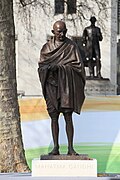
Ian Rank-Broadley FRBS is a British sculptor who has produced many acclaimed works, among which are several designs for British coinage and the memorial statue of Princess Diana at Kensington Palace in London unveiled on her 60th birthday in 2021.

The Albert Memorial, directly north of the Royal Albert Hall in Kensington Gardens, London, was commissioned by Queen Victoria in memory of her beloved husband Prince Albert, who died in 1861. Designed by Sir George Gilbert Scott in the Gothic Revival style, it takes the form of an ornate canopy or pavilion 176 feet (54 m) tall, in the style of a Gothic ciborium over the high altar of a church, sheltering a statue of the prince facing south. It took over ten years to complete, the £120,000 cost met by public subscription.

Sir William Hamo Thornycroft was an English sculptor, responsible for some of London's best-known statues, including the statue of Oliver Cromwell outside the Palace of Westminster. He was a keen student of classical sculpture and was one of the youngest artists to be elected to the Royal Academy, in 1882, the same year the bronze cast of Teucer was purchased for the British nation under the auspices of the Chantrey Bequest.
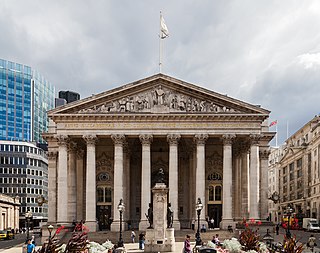
The Royal Exchange in London was founded in the 16th century by the merchant Sir Thomas Gresham on the suggestion of his factor Richard Clough to act as a centre of commerce for the City of London. The site was provided by the City of London Corporation and the Worshipful Company of Mercers, who still jointly own the freehold. The original foundation was ceremonially opened by Queen Elizabeth I who granted it its "royal" title. The current neoclassical building has a trapezoidal floor plan and is flanked by Cornhill and Threadneedle Street, which converge at Bank junction in the heart of the city. It lies in the Ward of Cornhill.

Old Trafford is a football stadium in Old Trafford, Greater Manchester, England, and the home of Manchester United. With a capacity of 74,310 it is the largest club football stadium in the United Kingdom, and the eleventh-largest in Europe. It is about 0.5 miles (800 m) from Old Trafford Cricket Ground and the adjacent tram stop.

František Bělský was a Czech sculptor.
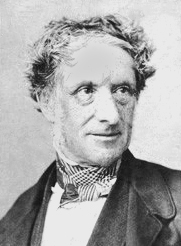
Sir Richard Westmacott was a British sculptor.

The Victoria Memorial is a monument to Queen Victoria, located at the end of The Mall in London, and designed and executed by the sculptor (Sir) Thomas Brock. Designed in 1901, it was unveiled on 16 May 1911, though it was not completed until 1924. It was the centrepiece of an ambitious urban planning scheme, which included the creation of the Queen’s Gardens to a design by Sir Aston Webb, and the refacing of Buckingham Palace by the same architect.
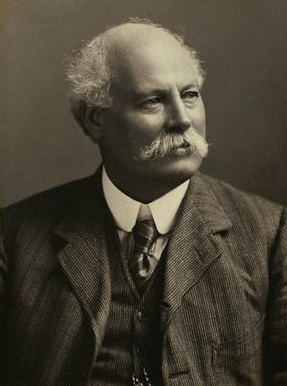
Sir Thomas Brock was an English sculptor and medallist, notable for the creation of several large public sculptures and monuments in Britain and abroad in the late nineteenth and early twentieth centuries. His most famous work is the Victoria Memorial in front of Buckingham Palace, London. Other commissions included the redesign of the effigy of Queen Victoria on British coinage, the massive bronze equestrian statue of Edward, the Black Prince, in City Square, Leeds and the completion of the statue of Prince Albert on the Albert Memorial.
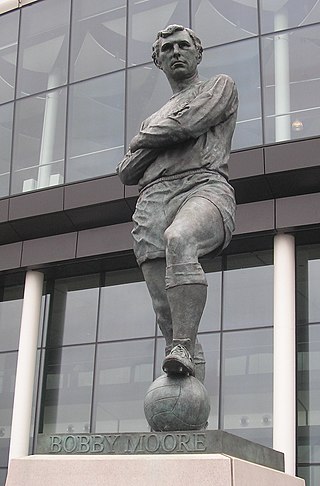
The Bobby Moore statue is a bronze sculpture of the former West Ham and England footballer Bobby Moore, situated directly outside England's national stadium, Wembley Stadium, in Wembley Park, north-west London. It commemorates the life of Moore, who captained the only England side ever to win the World Cup, defeating Germany 4–2 in the 1966 FIFA World Cup Final held in England at the old Wembley Stadium, demolished in 2003. Commissioned by the Football Association, it was unveiled outside the new stadium when it opened in 2007, fourteen years after Moore's death from cancer, aged 51. Standing 20 feet (6.1 m) tall on a stone plinth, it looks out over spectators as they walk down Wembley Way into the stadium. Sculpted by the Royal Sculptor Philip Jackson, it is Jackson's second piece featuring Moore, after the World Cup Sculpture unveiled in 2003.

The World Cup Sculpture, or simply The Champions, is a bronze statue of the 1966 World Cup Final located near the site of West Ham United Football Club's former Boleyn Ground stadium in the London Borough of Newham, England. It depicts a famous victory scene photographed after the final, held at the old Wembley Stadium in London, featuring Bobby Moore, Geoff Hurst, Martin Peters and Ray Wilson. It remains the only time the England national football team have won the World Cup, and England captain Moore is pictured held shoulder high by his colleagues, holding the Jules Rimet Trophy aloft.

The fourth plinth is the northwest plinth in Trafalgar Square in central London. It was originally intended to hold an equestrian statue of William IV, but remained bare due to insufficient funds. For over 150 years the fate of the plinth was debated; in 1998, the Royal Society for the encouragement of Arts, Manufactures and Commerce (RSA) commissioned three contemporary sculptures to be displayed temporarily on the plinth. Shortly afterwards, Chris Smith, Secretary of State for Culture, Media and Sport, commissioned Sir John Mortimer to seek opinions from public art commissioners, critics and members of the public as to the future of the plinth.

The Memorial to the Brigade of Gurkhas on Horse Guards Avenue, Whitehall, London, was unveiled by Queen Elizabeth II on 3 December 1997. This was the first memorial to Gurkha soldiers in the United Kingdom, and was occasioned by transfer of their headquarters and training centre from Hong Kong to London in 1997. The sculptor was Philip Jackson, working from a statue of 1924 by Richard Reginald Goulden in the Foreign and Commonwealth Office, and the plinth was designed by Cecil Denny Highton.
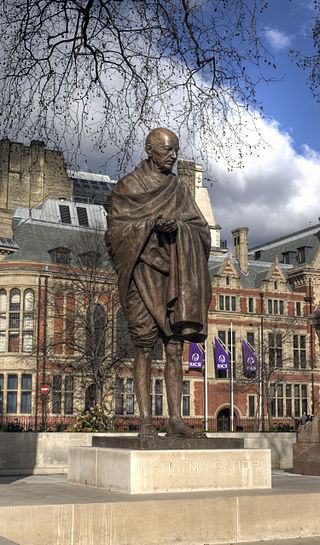
The statue of Mahatma Gandhi in Parliament Square, Westminster, London, is a work by the sculptor Philip Jackson.

The statue of William Slim, 1st Viscount Slim in Whitehall, London, is a work of 1988–1993 by the sculptor Ivor Roberts-Jones. It is one of three memorials to British military leaders of World War II on Raleigh Green, outside the Ministry of Defence's Main Building, the others being Oscar Nemon's 1980 statue of Lord Montgomery and Roberts-Jones's statue of Lord Alanbrooke, erected later in 1993. Slim's bronze statue stands approximately 3 metres (9.8 ft) high on a pedestal of Portland stone.

Hazel Reeves, MRSS SWA is a British sculptor based in Sussex, England, who specialises in figure and portrait commissions in bronze. Her work has been shown widely across England and Wales. Public commissions can be found in Carlisle, London, Congleton and Manchester.
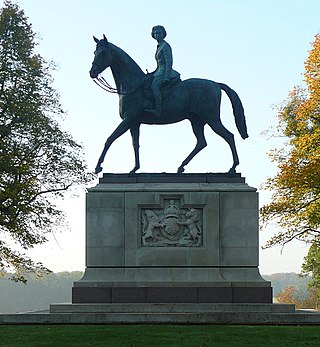
An equestrian statue of Elizabeth II stands in Windsor Great Park near Windsor, Berkshire. The statue, designed by sculptor Philip Jackson, was commissioned by the Crown Estate in honour of the queen's Golden Jubilee. The monument was dedicated in 2003.



